The SSD Relapse: Understanding and Choosing the Best SSD
by Anand Lal Shimpi on August 30, 2009 12:00 AM EST- Posted in
- Storage
What's Wrong with Samsung?
The largest SSD maker in the world is Samsung. Samsung makes the drives offered by Apple in its entire MacBook/MacBook Pro lineup. Samsung makes the drives you get if you order a Lenovo X300. In fact, if you're buying any major OEM system with an SSD in it, Samsung makes that drive.
It's just too bad that those drives aren’t very good.
This is the 4KB random write performance of Samsung's latest SSD, based on the RBB controller:
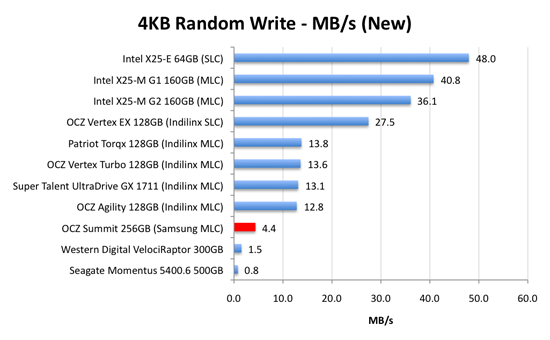
4.4MB/s. That's 3x the speed of a VelociRaptor, but 1/3 the speed of a cheaper Indilinx drive.
Speedy, but not earth shattering. Now let's look at performance once every LBA has been written to. This is the worst case scenario performance we've been testing for the past year:
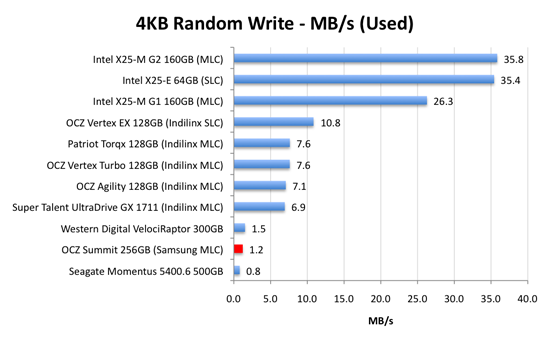
...and now we're down to mechanical hard drive speeds
Holycrapwtfbbq? Terrible.
Now to be fair to Samsung, this isn’t JMicron-terrible performance. It’s just not worth the money performance.
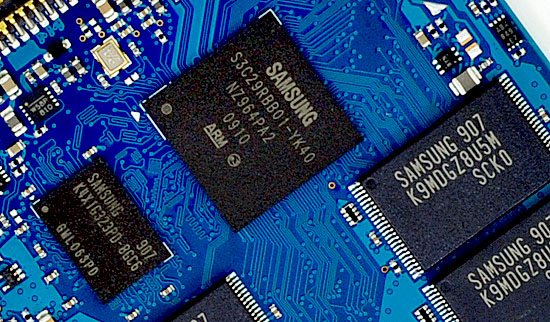
The Samsung RBB based SSDs are rebranded by at least two manufacturers: OCZ and Corsair.
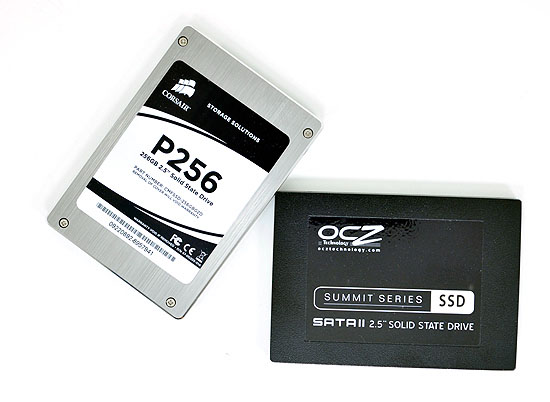
The OCZ Summit and the Corsair P256 both use the Samsung RBB platform.
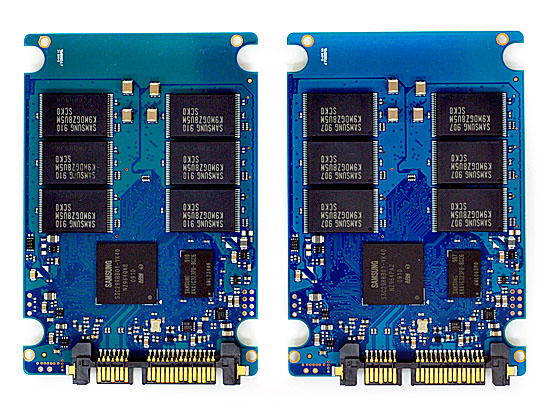
The Corsair and OCZ Samsung RBB drives.
The drive most OEMs are now shipping is an even older, lower performing Samsung SSD based on an older controller.
I talked to some of the vendors who ship Samsung RBB based SSDs and got some sales data. They simply can’t give these drives away. The Indilinx based drives outsell those based on the Samsung RBB controller by over 40:1. If end users are smart enough to choose Indilinx and Intel, why aren't companies like Apple and Lenovo?
Don't ever opt for the SSD upgrade from any of these OEMs if you've got the option of buying your own Indilinx or Intel drive and swapping it in there. If you don't know how, post in our forums; someone will help you out.
Samsung realized it had an issue with its used-state performance and was actually the first to introduce background garbage collection; official TRIM support will be coming later. Great right? Not exactly.
There’s currently no way for an end user to flash the firmware on any of these Samsung drives. To make matters worse, there’s no way for companies like OCZ or Corsair to upgrade the firmware on these drives either. If you want a new firmware on the drive, it has to go back to Samsung. I can’t even begin to point out how ridiculous this is.
If you’re lucky enough to get one of the Samsung drives with background garbage collection, then the performance drop I talked about above doesn’t really matter. How can you tell? Open up Device Manager, go to your SSD properties, then details, then select Hardware Ids from the dropdown. Your firmware version will be listed at the end of your hardware id string:
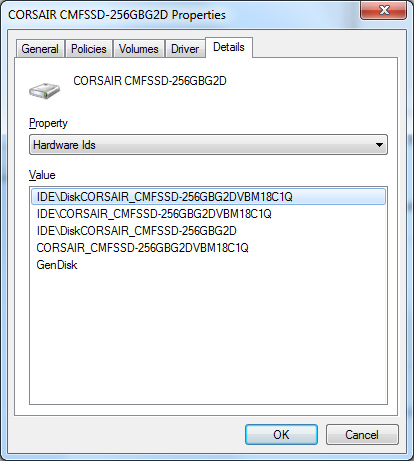
Version 1801Q doesn’t support BGC. Version 18C1Q (or later) does.
How can you ensure you get a model with the right firmware revision? Pick a religion and start praying, because that’s the best you can do.
Now the good news. When brand new, the Samsung drives actually boast competitive sequential write, sequential read and random write speeds.
These drives are also highly compatible and very well tested. For all of the major OEMs to use them they have to be. It’s their random write performance that’s most disappointing. TRIM support is coming later this year and it will help keep the drives performing fresh, but even then they are still slower than the Indilinx alternatives.
There’s no wiper tool and there’s currently no method to deploy end-user flashable firmware updates. Even with TRIM coming down the road, the Samsung drives just don’t make sense.










295 Comments
View All Comments
shabby - Monday, August 31, 2009 - link
The 80gig g2 is $399 now!gfody - Tuesday, September 1, 2009 - link
The gen2 80gb is at $499 as of 12:00AM PSTmaxfisher05 - Monday, August 31, 2009 - link
As of right now (8/31) newegg has the 160GB Intel G2 listed at $899!!!!!!!!!!!!!!!!!!! To quote Anand "lolqtfbbq!"siliq - Monday, August 31, 2009 - link
Great article! Love reading this. Thanks Anand.We gather from this article that all the pain-in-@$$ about SSDs come from the inconsistency between the size of the read-write page and the erase block. When SSDs are reading/writing a page it's 4K, but the minimum size of erasing operation is 512K. Just wondering is there any possibility that manufacturers can come up with NAND chips that allows controllers to directly erase a 4K page without all the extra hassles. What are the obstacles that prevent manufacturers from achieving this today?
bji - Tuesday, September 1, 2009 - link
It is my understanding that flash memory has already been pushed to its limit of efficiency in terms of silicon usage in order to allow for the lowest possible per-GB price. It is much cheaper to implement sophisticated controllers that hide the erase penalty as much as possible than it is to "fix" the issue in the flash memory itself.It is absolutely possible to make flash memory that has the characteristics you describe - 4K erase blocks - but it would require a very large number of extra gates in silicon and this would push the cost up per GB quite a bit. Just pulling numbers out of the air, let's say it would cost 2x as much per GB for flash with 4K erase blocks. People already complain about the high cost per GB of SSD drives (well I don't - because I don't steal software/music/movies so I have trouble filling even a 60 GB drive), I can't imagine that it would make market sense for any company to release an SSD based on flash memory that costs $7 per GB, especially when incredible performance can be achieved using standard flash, which is already highly optimized for price/performance/size as much as possible, as long as a sufficiently smart controller is used.
Also - you should read up on NOR flash. This is a different technology that already exists, that has small erase blocks and is probably just what you're asking for. However, it uses 66% more silicon area than equivalent NAND flash (the flash used in SSD drives), so it is at least 66% more expensive. And no one uses it in SSDs (or other types of flash drives AFAIK) for this reason.
bji - Tuesday, September 1, 2009 - link
Oh I just noticed in the Wikipedia article about NOR flash, that typical NOR flash erase block sizes are also 64, 128, or 256 KB. So the eraseblocks are just as problematic there as in NAND flash. However, NOR flash is more easily bit-addressable so would avoid some of the other penalties associated with NAND that the smart contollers have to work around.So to make a NAND or NOR flash with 4K eraseblocks would probably make them both 2X - 4X more expensive. No one is going to do that - it would push the price back out to where SSDs were not viable, just as they were a few years ago.
siliq - Tuesday, September 1, 2009 - link
Amazing answers! Thank you very muchmorrie - Monday, August 31, 2009 - link
My laptop is limited to 4 GB swap. While that's enough for 99% of Linux users, I don't shut down my laptop, it's used as a desktop with dozens of apps running and hundreds of browser tabs. Therefore, after a few months of uptime, memory usage climbs above 4 GB. I have two hard drives in the laptop, and set up a software raid0 1GB swap partition, but I went with software raid1 for the other swap partition. So once the ram is used up for swap, the laptop slows noticeably, but after the raid0 swap partition fills up, the raid1 partition really slows it down. Once that fills up, it hits swap files (non raid) which slow it down more. But thanks to the kernel and the way swappiness works, once about 4 GB of Ram plus about 3 GB of physical swap is used, it really slows. I can gain a bit of speed by adding some physical swap files to increase the ratio of physical swap to ram swap (thus changing swappiness through other means), but this only works for another 1 GB of ram.No lectures or advice please, on how I'm using up memory or about how 4GB is more than sufficient, my uptimes are in the hundreds of days on this laptop and thanks to ADD/limited attention span, intermittent printer availability for printing out saved browser tabs and other reasons (old habits dying hard being one), my memory usage is what it is.
So, the big question is, since the laptop has an eSATA port, can I install one of these ssd drives in an externel SATA tray, connected via eSATA to the laptop and move physical swap partitions to the ssd? I believe that swap on the ssd would be a lot faster even on the eSATA wire, than swap on the drives in the laptop (they're 7200 rpm drives btw). I'm aware that using the ssd for swap would shorten it's life, but if it lasts a year till faster laptops with more memory are available (and I get used to virtual machines and saving state so I can limit open browser windows), I'll be happy.
Buying two of the drives and using them raided in the laptop is too costly right now, when prices drop that'll be a solution for this current laptop.
Externel SSD over eSATA for Linux swap on a laptop? Faster than my current setup?
hpr - Monday, August 31, 2009 - link
Sounds like you have some very small memory leak going on there.Have you tried that Firefox plugin that enables you to have your tabs but it doesn't really have a tab open in memory.
TooManyTabs
https://addons.mozilla.org/en-US/firefox/addon/942...">https://addons.mozilla.org/en-US/firefox/addon/942...
Have fun filling up thousands of tabs and having low memory usage.
gstrickler - Monday, August 31, 2009 - link
You should be able to use an SSD in an eSATA case, and yes, it should be faster than using your internal 7200 RPM drives. You probably want to use an Intel SSD for that (see page 19 of the article and note that the Intel drives don't drop off dramatically with usage).If you don't need to storage of your two internal 7200 RPM drives (or if you can get a sufficiently large SSD), you might be better off replacing one of them with an SSD and reconsider how you're allocating all your storage.
As for printer availability, seems to me it would make more sense to use a CUPS based setup to create PDFs rather than having jobs sit in a print queue indefinitely. Then, print the PDFs at your convenience when you have a printer available. I don't know how your printing setup currently works, but it sounds like doing so would reduce your swap space usage.